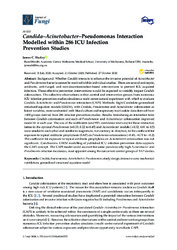Please use this identifier to cite or link to this item:
http://hdl.handle.net/11054/1712Full metadata record
| DC Field | Value | Language |
|---|---|---|
| dc.contributor | Hurley, James C. | en_US |
| dc.date.accessioned | 2021-01-07T03:06:52Z | - |
| dc.date.available | 2021-01-07T03:06:52Z | - |
| dc.date.issued | 2020 | - |
| dc.identifier.govdoc | 01664 | en_US |
| dc.identifier.uri | http://hdl.handle.net/11054/1712 | - |
| dc.description.abstract | Background: Whether Candida interacts to enhance the invasive potential of Acinetobacter and Pseudomonas bacteria cannot be resolved within individual studies. There are several anti-septic, antibiotic, anti-fungal, and non-decontamination-based interventions to prevent ICU acquired infection. These effective prevention interventions would be expected to variably impact Candida colonization. The collective observations within control and intervention groups from numerous ICU infection prevention studies simulates a multi-centre natural experiment with which to evaluate Candida, Acinetobacter and Pseudomonas interaction (CAPI). Methods: Eight Candidate-generalized structural equation models (GSEM), with Candida, Pseudomonas and Acinetobacter colonization as latent variables, were confronted with blood culture and respiratory tract isolate data derived from >400 groups derived from 286 infection prevention studies. Results: Introducing an interaction term between Candida colonization and each of Pseudomonas and Acinetobacter colonization improved model fit in each case. The size of the coefficients (and 95% confidence intervals) for these interaction terms in the optimal Pseudomonas (+0.33; 0.22 to 0.45) and Acinetobacter models (+0.32; 0.01 to 0.5) were similar to each other and similar in magnitude, but contrary in direction, to the coefficient for exposure to topical antibiotic prophylaxis (TAP) on Pseudomonas colonization (-0.45; -0.71 to -0.2). The coefficient for exposure to topical antibiotic prophylaxis on Acinetobacter colonization was not significant. Conclusions: GSEM modelling of published ICU infection prevention data supports the CAPI concept. The CAPI model could account for some paradoxically high Acinetobacter and Pseudomonas infection incidences, most apparent among the concurrent control groups of TAP studies. | en_US |
| dc.description.provenance | Submitted by Gemma Siemensma (gemmas@bhs.org.au) on 2021-01-07T00:49:46Z No. of bitstreams: 0 | en |
| dc.description.provenance | Approved for entry into archive by Gemma Siemensma (gemmas@bhs.org.au) on 2021-01-07T03:06:52Z (GMT) No. of bitstreams: 1 jof-06-00252-v2.pdf: 1617025 bytes, checksum: e33be7fe3fcbc5ff7c2e64f2f6463641 (MD5) | en |
| dc.description.provenance | Made available in DSpace on 2021-01-07T03:06:52Z (GMT). No. of bitstreams: 1 jof-06-00252-v2.pdf: 1617025 bytes, checksum: e33be7fe3fcbc5ff7c2e64f2f6463641 (MD5) Previous issue date: 2020 | en |
| dc.title | Candida- Acinetobacter-Pseudomonas interaction modelled within 286 ICU infection prevention studies. | en_US |
| dc.type | Journal Article | en_US |
| dc.type.specified | Article | en_US |
| dc.bibliographicCitation.title | Journal of Fungi | en_US |
| dc.bibliographicCitation.volume | 6 | en_US |
| dc.bibliographicCitation.issue | 4 | en_US |
| dc.bibliographicCitation.stpage | 252 | en_US |
| dc.subject.healththesaurus | ACINETOBACTER | en_US |
| dc.subject.healththesaurus | CANDIDA | en_US |
| dc.subject.healththesaurus | PSEUDOMONAS | en_US |
| dc.subject.healththesaurus | BACTERAEMIA | en_US |
| dc.subject.healththesaurus | GENERALIZED STRUCTURAL EQUATION MODEL | en_US |
| dc.subject.healththesaurus | INTENSIVE CARE | en_US |
| dc.subject.healththesaurus | MECHANICAL VENTILATION | en_US |
| dc.subject.healththesaurus | STUDY DESIGN | en_US |
| dc.identifier.doi | https://doi.org/10.3390/jof6040252 | en_US |
| Appears in Collections: | Research Output | |
Files in This Item:
| File | Description | Size | Format | |
|---|---|---|---|---|
| jof-06-00252-v2.pdf | 1.58 MB | Adobe PDF |  View/Open |
Items in DSpace are protected by copyright, with all rights reserved, unless otherwise indicated.
